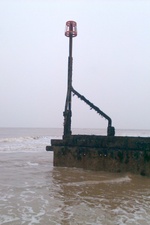Cromer coast protection scheme
The sea defences at Cromer protect the town from the force of the North Sea.
They were built in various phases as the town expanded, the earliest dating back to 1845. Over the years the walls and groynes have withstood many storms and have been maintained, enhanced and repaired as and when required. A booklet on Cromer Seafront Heritage, has been put together which draws on local archives and provides a background to the interactions between the sea and the town over the past two centuries.
The current scheme is being designed not only to maintain the existing level of defence, but also to withstand up to 50 years of predicted of sea level rise.
The Cromer coast protection scheme will:
- reduce the impact of the sea along the Cromer frontage
- help to preserve a stable beach in front of the seawalls for as long as possible
- preserve the amenity of the beach, including beach access
- maintain the historic and visual character of Cromer’s sea front.
Information Boards have been erected at strategic points along the frontage and an information leaflet on the refurbishment of sea walls and groynes 2013 to 2015 has been produced to provide more information about the scheme.
Work on the third and final phase has now started and will continue until March 2016, although no work will take place over the Easter Bank holiday there will be restricted access to the promenade during this period. Cromer is very much open for business and Cromer's Pier Show will go on!
Refurbishment of sea walls and groynes 2013 to 2015
The work will include re-facing the existing sea walls with concrete, improving the parapet walls where necessary and repairing the timber groynes.
The historical significance of some of the structures has been carefully taken into account and the overall character of the promenade should not change.
The total cost of the scheme is approximately £10m, funded by the Department of Environment Food and Rural Affairs, although the works will be managed by NNDC.
The work is provisionally programmed to take place from the autumn 2013 to spring 2014 and autumn 2014 to spring 2015.
An outline of the work to be completed before the end of March 2014 is set out below:
End of January/Beginning of February 2014:
- Underpin the bottom of the zig zag slope at the western end.
- Inspection of nearby properties to record any existing issues prior to work commencing.
- Initial groyne works and inspections including replacement of missing boards caused by December surge where this is seen as a priority.
February 2014 through to the end of March 2014:
- Drilling holes for reinforcing dowels in sea wall.
- Piling where detailed as part of scheme across the frontage.
The contractors are looking to complete section 2 and some of section 3 (west promenade) by the end of March 2014.
What is a timber groyne?
 Groynes are the timber structures that jut out from the beach into the sea.
Groynes are the timber structures that jut out from the beach into the sea.
Their main function is to trap the sand and flint on the beach which in this location is otherwise continuously moved by wind, wave and tide in a predominantly easterly direction.
The beach is not only important for visitors; it helps to absorb the force of the waves before they reach the sea wall and the cliff. It also provides support for the sea wall foundations.
Some groynes have ‘beacons’ on their seaward end to mark them when submerged at high water.
Cromer coast protection scheme meetings
Dates for future meetings
- Wednesday, 16th March 2016
- Wednesday, 10th February 2016
- Wednesday, 13th January 2016
- Wednesday, 2nd December 2015
Minutes of public meetings held by the various CCPS liaison groups are published here.
- Stakeholders Group March 2016
- Stakeholders Group February 2016
- Stakeholders Group January 2016
- Stakeholders Group December 2015
- Stakeholders Group November 2015
- Stakeholders Group October 2015
- Stakeholders Group 18 March 2015
- Stakeholders Group 18 February 2015
- Stakeholders Group 21 January 2015
- Stakeholders Group 17 December 2014
- Stakeholder Group 19 November 2014
- Stakeholder Group 15 October 2014
- Business & Traders 17 September 2014
- Liaison Group 17 September 2014
- Liaison Group 18 March 2014
- Liaison Group 18 February 2014
- Liaison Group 14 January 2014
- Liaison Group 16 December 2013
- Liaison Group 15 October 2013
Still need help?
Visit our contact us page for further assistance about our popular services and information.
